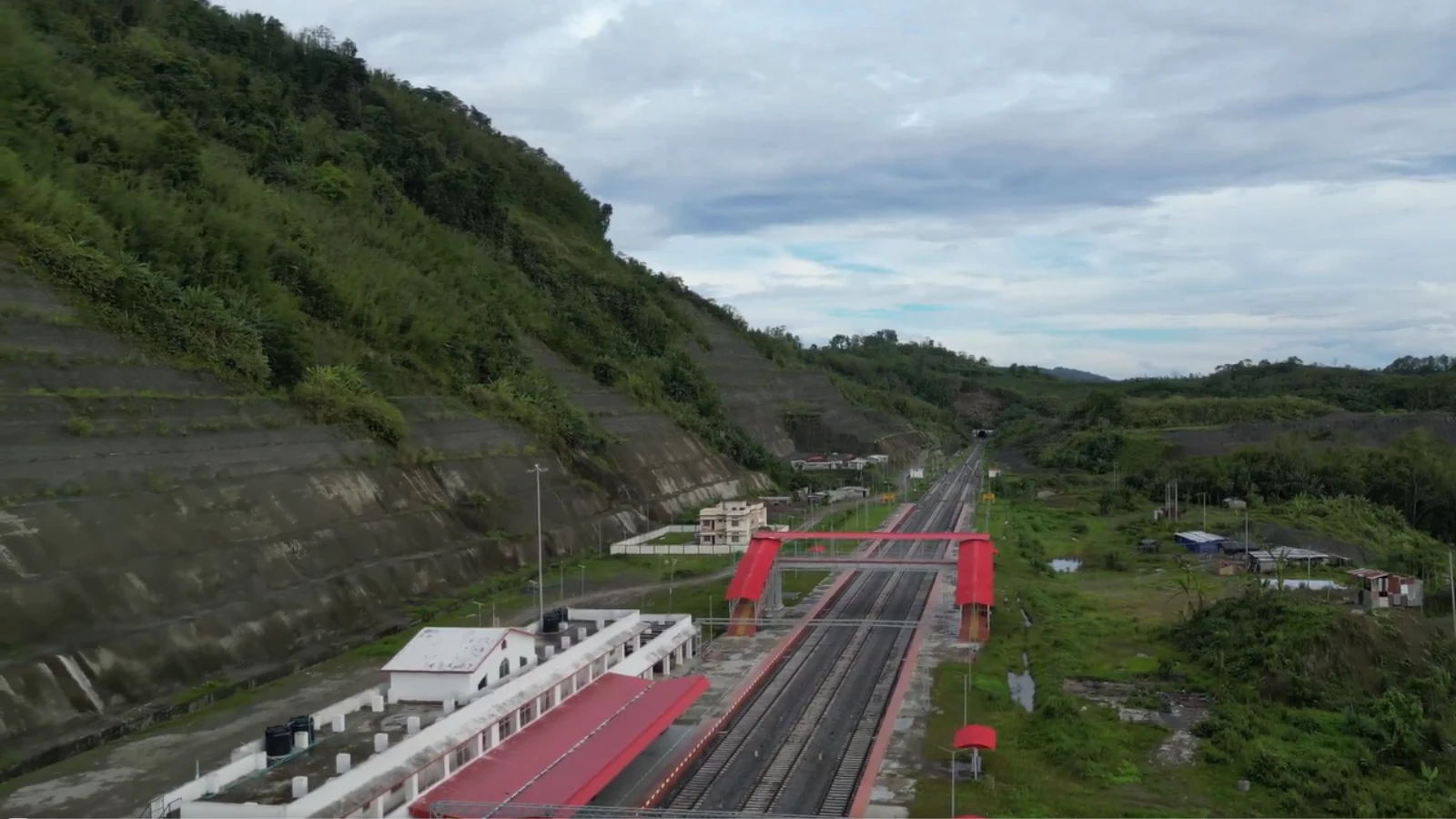By Akhileshwar Sahay,News18
Copyright news18

On the morning of 15 September, a new train chugged into Anand Vihar station in New Delhi. It was no ordinary train. Numbered 20507, it had departed from Sairang, the newest station in the Indian railway grid, on Saturday morning and reached Delhi after more than 42 hours, covering a distance of 2,512 kilometres.
This arrival was a milestone moment for Bharat. It connected the previously inaccessible state of Mizoram to the rest of the nation, bringing its capital onto the railway map. Sairang lies on the outskirts of Aizawl, Mizoram’s capital.
A Moment Of Reckoning
Two days earlier, on 13 September, Prime Minister Narendra Modi inaugurated a 51.38-kilometre railway line linking Bairabi station to the newly built Sairang station, about 20 km from Aizawl. It marked a major step in reimagining Bharat’s Northeast and accelerating Mizoram’s integration with the rest of the country.
The occasion also saw the flagging off of three new train services:
Sairang–Delhi Rajdhani Express
Sairang–Guwahati Express
Sairang–Kolkata Express
With this, Mizoram, once a remote and impenetrable region at the country’s edge, is now connected not only by railway but also by opportunity. This development heralds a new era of tourism, commerce, mobility, and deeper national integration.
Better Late Than Never
A rail link connecting Mizoram to the rest of the country had long been overdue. The idea dates back to 1979, when it was decided that every Northeast state would get at least one railway line. The post of General Manager (Construction), Northeast Frontier Railway was created to realise that vision in mission mode.
However, the dream remained unrealised for decades. Bairabi station in Mizoram, located about five kilometres inside the state near the Assam border, was built in the late 1980s as a metre-gauge station, but further progress stalled for various reasons.
Hope resurfaced in 2016 when Bairabi was upgraded to broad gauge under the 83.55 km Katakhal–Bairabi Gauge Conversion Project. It received its first freight train carrying 42 wagons of rice, and passenger services up to Bairabi were flagged off by PM Modi. That was the beginning.
A quiet rail revolution soon followed. In his first term, PM Modi revived the construction of the 51.38 km Bairabi–Sairang section. He laid the foundation in 2014, land acquisition followed in 2015, and execution began in 2015–16. The line was completed and commissioned within ten years despite numerous challenges.
It now links Mizoram to the national network via Silchar in Assam, and forms part of the ambitious 223 km Sairang–Hmawngbuchhuah railway line that aims to extend connectivity to Mizoram’s southern border, opening direct trade routes to Myanmar and Southeast Asia through the Sittwe Port.
The new line has drastically reduced both travel time and costs for Mizoram’s residents. The Aizawl–Guwahati journey now takes 12 hours by train instead of 16 by road. Travel between Aizawl and Silchar is cut from seven hours to just three. The road travel cost from Silchar to Aizawl, a distance of about 150 km, has dropped from Rs 1,000 to under Rs 80. Meanwhile, the AC 3-tier fare to Delhi is now Rs 3,625.
Indubitably, this is a boon for Mizoram’s people, who can now access better opportunities for travel, education, employment, business, and healthcare in hubs like Delhi, Kolkata, Guwahati, and Silchar like never before.
Challenges Galore
It was a project that tested the resolve of railway personnel due to the sheer scale of challenges. The most significant among them were:
Firstly, the Survey Conundrum: With the terrain passing through towering mountains, deep gorges, and dense forests, extending the line beyond Bairabi was a humongous task. The survey work alone took more than a decade to complete.
The Preliminary Engineering cum Traffic (PET) Survey, sanctioned in September 1999, was jinxed due to thick forest cover, poor visibility, and agitation by local communities.
The Reconnaissance Engineering cum Traffic (RET) Survey was carried out by NF Railway between 2003 and 2006.
Pre-construction surveys and geotechnical investigations were conducted by RITES between 2006 and 2011.
The entire project took ten years to complete, at a final cost of Rs 8,070 crore.
Secondly, Undulating Terrain and Construction Difficulties: Piercing tall mountains and deep valleys with steep gradients, in undulating terrain surrounded by dense forests, proved to be a serious challenge. Engineers had to first construct over 200 km of roads just to access the construction site.
The magnitude of the terrain’s difficulty is evident from the fact that, to construct just 51.38 km of railway line, 45 tunnels were bored — the longest measuring 1.87 km — and 153 bridges were built, including 55 major bridges. The longest bridge spans 1.3 km, while the tallest reaches 114 metres from the base, higher than the Qutub Minar.
Thirdly, the Tyranny of Weather: Climatic conditions posed severe constraints, with only four months in a financial year — from November to March — suitable for construction activity.
Fourthly, the Logistics Conundrum: Due to the unavailability of critical construction materials such as steel, cement, earth, sand, and stone in Mizoram, the Railways had to source them from neighbouring states, including Assam, West Bengal, Bihar, Jharkhand, and Meghalaya.
Here is a glimpse of the logistical effort involved. Crushed stones were brought from Assam, West Bengal, and Jharkhand, while sand was sourced from Assam. Reinforcement rods came from Kolkata, and steel girders were transported from Chhattisgarh, West Bengal, and Maharashtra. Labourers came from West Bengal, Assam, Bihar, Jharkhand, and Uttar Pradesh.
Transporting the girders to the construction sites posed a huge logistical challenge. Engineers had to carry them by rail up to Bairabi, and from there to various sites using specially arranged transportation. As Vinod Kumar, Principal Chief Engineer of NFR, aptly summed it up, “Sometimes it took more than a month to complete a day’s work due to the logistic issues.”
Fifth, the Labour Trouble: The terrain was so hostile that it was extremely difficult to find construction labour, let alone retain those who arrived. Poor mobile connectivity and harsh site conditions made workers unwilling to stay. Many who went home for a break never returned.
Despite these formidable challenges, railway connectivity to Mizoram has finally arrived, and grandly so, as a boon to the residents and economy of the state. With this, Mizoram becomes the fourth Northeastern state with its capital city connected to the national railway network. The other three are Assam, Tripura, and Arunachal Pradesh.
History Recapitulated
According to a PIB note dated 4 February 2011, the Bairabi–Sairang project was originally scheduled for completion by March 2015. In reality, its foundation stone was laid by Prime Minister Narendra Modi only in late September 2014, land acquisition followed in 2015, construction commenced in 2016, and the line was finally commissioned a decade later on 15 September 2025.
The laying of the foundation itself had to wait until 2014, when PM Modi finally cast it in stone. And the actualisation of the dream had to wait another ten years.
This delay brings forth a broader question: why have the Northeastern states remained disconnected from the mainland for so long, where do things stand today, and where are we headed? Here is a brief recapitulation of that journey:
One, Long Dependent on the Chicken’s Neck: Since the time of colonial isolation, the sole lifeline to the Northeast has been the narrow Siliguri Corridor, also known as the “Chicken’s Neck” — a narrow strip of land in West Bengal, about 20–22 km wide at its narrowest point. This corridor, bordered by Nepal to the north and Bangladesh to the south, is the only land route for transporting goods, people, and military assets between the Northeast and the rest of India.
The Chicken’s Neck handles about 95 per cent of all land-based movement of people and goods to and from the region. Its extreme narrowness makes it highly vulnerable to disruptions, whether caused by natural calamity, political instability, or military conflict. Any such disruption could effectively sever the Northeast from the mainland. Its proximity to China’s Chumbi Valley, at the tri-junction of India, Bhutan, and China, also gives it immense strategic significance. Any conflict in this area is widely seen as a potential threat to India’s territorial integrity.
Because all land-based access depends on this single, slender corridor, the Northeast has often felt both physically and psychologically isolated. Any bottleneck, blockade, or hostile action has a disproportionate impact on the region’s economy, accessibility, and security. This isolation has, for decades, hampered investment, trade, and social integration, significantly affecting regional development.
Two, Limited to Assam: Before independence, Assam was the only Northeastern state with a railway network. The British constructed railways in Assam in the late 19th century primarily to transport coal and tea for export via the port of Chittagong. The Assam Railways and Trading Company built the first metre-gauge line from the Dibrugarh steamer port to Jaipur, opened on 1 May 1882, which was later extended to Chabua. The Assam Bengal Railway, incorporated in 1892, created a vital link from Chittagong to Tinsukia, connecting Assam’s tea and coal regions to global markets.
By the early 20th century, Assam had a substantial railway network. But that connectivity was soon disrupted.
Three, Disruption and Disconnection: Before 1947, Assam’s main rail link to Calcutta ran via East Bengal (later East Pakistan, now Bangladesh). Partition severed that corridor overnight, cutting Assam off from the rest of India. The situation worsened after the July 1947 referendum led to the transfer of Sylhet to East Bengal, further altering alignment and accessibility.
Four, The Grand Project: This disconnection led to the emergency sanctioning of the Assam Rail Link Project (ARLP), carried out between 1948 and 1950. Despite the difficult terrain, Assam’s rail connectivity to the rest of India was restored on 26 January 1950. The grand project was completed under the leadership of Indian Railways Chief Engineer, Sardar Karnail Singh.
Five, Neglected for Decades: Though the Assam Rail Link Project was completed in less than two years — a record — it did not lead to broader momentum for rail development in the Northeast. Progress remained minimal for decades. Whatever little development took place was largely confined to Assam.
Six, Rays of Hope: The setting up of the North Eastern Council (NEC) by an Act of Parliament in 1971 brought renewed hope. The NEC’s single biggest budget head for years was transport connectivity. Encouraged by the Council, the Government of India decided to construct at least one railway line in each of the six hill states — Arunachal Pradesh, Manipur, Meghalaya, Mizoram, Nagaland, and Tripura. The Railway Ministry created a dedicated NFR Construction Organisation in Maligaon to execute these projects.
Seven, Stalled: In the decades that followed, many railway projects were announced, but progress on the ground remained negligible. As of 4 February 2011, a Government of India statement listed the following Northeast railway projects along with their targeted completion dates:
Mizoram – Bairabi–Sairang: March 2015
Arunachal Pradesh – Harmuti–Itanagar: March 2012
Manipur – Jiribam–Tupul: March 2014 and Tupul–Imphal: March 2016
Meghalaya – Azra–Byrnihat: March 2014 and Byrnihat–Shillong: March 2017
Nagaland – Dimapur–Zubza: March 2015
Sikkim – Sivok–Rangpo: December 2015
While reasons cited may vary, from terrain challenges to administrative delays, the truth remains that nearly all these projects were stalled. The principal reason was a lack of political will and ownership at the highest levels.
Moving beyond the political optics, and unsurprisingly so, the Narendra Modi era, with its laser-sharp attention to detail, has marked a new dawn for the transformation of the Northeast through the laying of steel tracks, thereby integrating the region with the rest of the country. I have already outlined the story of the Bairabi–Sairang project. Narrated below is the 11-year story of railway progress across the other Northeastern states.
Firstly, Nagaland: From One Station to a Capital Link
Dimapur, opened in the early 20th century, remained Nagaland’s lone railhead for over 100 years.
In 2022, Shokhuvi ended that isolation by becoming the state’s second station.
The 82.5 km Dimapur–Kohima new line is progressing steadily, with the Dhansiri–Shokhuvi section commissioned in October 2021 and the first passenger service, the Donyi Polo Express, rolling out in August 2022.
The Shokhuvi–Molvom section was completed in March 2025, while the remaining Molvom–Zubza stretch, near Kohima, is in progress.
By October 2026, the 14.09 km Molvom–Pherima stretch is expected to open, followed by the 37.57 km Pherima–Zubza section in December 2029 — a milestone that will finally bring rail connectivity to Nagaland’s capital, Kohima.
Secondly, Arunachal Pradesh: Rails Beyond Frontiers
Naharlagun station, which connects to Itanagar, was commissioned in April 2014 under the 21.75 km Harmuti–Naharlagun New Line Project.
The Balipara–Bhalukpong line was converted to broad gauge in May 2015 as part of the larger 505 km Rangiya–Murkongselek project.
The Murkongselek–Pasighat line is currently under construction: the Murkongselek–Sille (15.6 km) section is due in October 2025, and the Sille–Pasighat (10.55 km) stretch is expected by February 2026.
Final Location Surveys (FLS) have been completed for new lines to Tawang, Pasighat–Parashuram Kund–Wakro, and Bame–Aalo–Mechuka.
Thirdly, Tripura: Connecting Border and Beyond
The 152 km Badarpur–Agartala line was converted to broad gauge in April 2016.
The Agartala–Sabroom line (112 km) extended railways to the southernmost part of Tripura, close to the Bangladesh border, in phases between 2016 and 2019.
The entire railway network in Tripura has now been electrified.
Fourthly, Manipur: Linking Hills and Valleys to the Nation
Jiribam station, close to the Assam border, was converted from metre gauge to broad gauge in March 2016 under the 49.61 km Arunachal–Jiribam project.
The 110.625 km Jiribam–Imphal line is under progress. The Jiribam–Vangaichungpao (11.8 km) section was commissioned in February 2017, followed by the Vangaichungpao–Khongsang (43.56 km) stretch.
The Khongsang–Awangkhul (9.1 km) section is slated for completion by March 2026, Awangkhul–Noney (9.15 km) by March 2027, and the Noney–Imphal (37.02 km) segment by March 2028.
Beyond The Above
There is fast-track movement in the remaining two states as well. In Sikkim, the 44.96 km Sevok–Rangpo line, set to provide the state’s first railway connectivity, is targeted for completion by December 2027. In Meghalaya, Mendipathar became the first railway station in 2014 under the 19.62 km Dudhnoi–Mendipathar project, with 8.67 km of railway track lying inside Meghalaya.
Beyond The Obvious
Undoubtedly, the targets mentioned above are official estimates. But given the pace of construction and commissioning of railway projects since 2014, and the strategic imperative of improving connectivity in the post-Doklam scenario, delays — if any — are likely to be a matter of months, or at worst, a year or two. They are unlikely to stretch into decades, as had been the case earlier.
The New Horizons
With more railway projects on the horizon, the Northeast is clearly witnessing a quiet revolution through steel tracks. As the government has repeatedly asserted, in just over a decade the region has seen century-old metre-gauge lines upgraded, long-delayed projects revived, and capital cities like Aizawl and Imphal finally placed on the railway map.
While Assam, the old rail bastion, has emerged as the backbone through electrification and track-doubling, frontier states like Mizoram, Nagaland, and Arunachal Pradesh are pushing rail lines towards the borders and trade gateways. Tripura has already extended connectivity to Bangladesh, and Meghalaya and Sikkim await their turn.
Together, these milestones are more than engineering achievements; they symbolise a Northeast steadily moving from isolation to integration, with steel tracks carrying the promise of growth, connectivity, and new horizons.
The Key Learning
In the past decade, Indian Railways has proven its mettle, not only by completing the difficult Kashmir rail project but also by fast-tracking railway construction through the impenetrable hills, valleys, and forests of the Northeast. For Bharat to become a developed nation by 2047, it will need the rapid and time-bound construction of tens of thousands of kilometres of railway lines, including high-speed corridors across the country.
It is time to raise the bar and bring the same discipline and sense of urgency to the rest of the nation.
The author is a multidisciplinary thought leader with Action Bias, India-based international impact consultant, and keen watcher of changing national and international scenarios. He works as president, advisory services of consulting company BARSYL. Views expressed in the above piece are personal and solely those of the author. They do not necessarily reflect News18’s views.



